|
 Aug 18-25, 1999 Kyoto, Japan Aug 18-25, 1999 Kyoto, JapanIt's on the steps just outside the translucent, gridded white paper walls of
the Higashi Hongan-ji Temple, that we pull off our sandals, step across the threshold, and
enter the sanctuary of the cavernous Great Founder's Hall. Entranced and in awe, we
shuffle slowly across the huge expanse of the empty, furniture-less floor, in towards the
altar that stretches stately across the temple's far wall. With each new step, I can feel
myself gradually being seduced by the smooth feel of the rice straw tatami mats, cool
against the tender skin of my bare feet. And becoming spellbound by the subtle, husky,
fresh-hay smell of those same mats. And being enveloped by the simple, soothing, but rich
combination of the temple's three predominate hues - the muted blonde of the tamati mats,
the chocolate-brown of its pillars and beams, and the lustrous gold of the fixtures and
inlay.
 As we settle on a spot to the right
rear of the hall and squat down for a rest, I'm distracted by motion in one of the immense
chamber's far corners. A dark-robed priest emerges from the shadows and silently glides
across the lacquered floor of the alter, inwards towards its center. With a quick turn, he
faces the gilded altar table and initiates his secretive rituals. As we settle on a spot to the right
rear of the hall and squat down for a rest, I'm distracted by motion in one of the immense
chamber's far corners. A dark-robed priest emerges from the shadows and silently glides
across the lacquered floor of the alter, inwards towards its center. With a quick turn, he
faces the gilded altar table and initiates his secretive rituals.
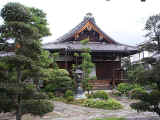 This is it, I think to myself. This is just how I thought it would be. This
is exactly how I'd imagined it would be like, look like, smell
like, and feel like to be here, visiting this strange and unfamiliar land on the
other side of the globe. In fact, even though it was almost two years ago, I can still
remember distinctly the moment that we jotted down 'Japan' on our wish list of stops for
this trip. I remember daydreaming about the grace and beauty of the astute but shy geisha
girls, the skillful and shameless political maneuvering of the ruthless shogunates, and
the legendary fighting feats of the fearless samurai warriors. This is it, I think to myself. This is just how I thought it would be. This
is exactly how I'd imagined it would be like, look like, smell
like, and feel like to be here, visiting this strange and unfamiliar land on the
other side of the globe. In fact, even though it was almost two years ago, I can still
remember distinctly the moment that we jotted down 'Japan' on our wish list of stops for
this trip. I remember daydreaming about the grace and beauty of the astute but shy geisha
girls, the skillful and shameless political maneuvering of the ruthless shogunates, and
the legendary fighting feats of the fearless samurai warriors.
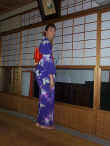 And now here we are, in
the heart of Kyoto, or 'Hana no Miyako' (the 'Flowering Capital' as it's called by many
Japanese) simply soaking in the ambience and character of the ancient and mystic Japan.
Even though Tokyo now serves as the country's administrative capital, Kyoto still blooms
with fields of the archipelago's open-air archives. It's not surprising that, as the
capital of Japan for over 1,000 years (half of the country's recorded history), Kyoto
holds a unique place in the hearts of the nation's citizens, and commands a choice spot on
the itinerary of the country's visitors. And now here we are, in
the heart of Kyoto, or 'Hana no Miyako' (the 'Flowering Capital' as it's called by many
Japanese) simply soaking in the ambience and character of the ancient and mystic Japan.
Even though Tokyo now serves as the country's administrative capital, Kyoto still blooms
with fields of the archipelago's open-air archives. It's not surprising that, as the
capital of Japan for over 1,000 years (half of the country's recorded history), Kyoto
holds a unique place in the hearts of the nation's citizens, and commands a choice spot on
the itinerary of the country's visitors.
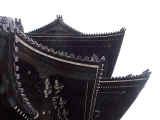 There's just so much to see and experience here.
From the gracefully curving slopes of the city's temple roofs, jutting skywards aside the
carefully combed pebbles of her rock gardens; to the crisp purposeful lines of the former
capital's aged wooden houses, neatly lining the narrow cobbled lanes of her quiet
thoroughfares, it's all here. Ironically, it's the sheer beauty and number of these very
treasures that have saved the city that holds them, from the ravages of war. Story has it,
that the former imperial seat is one of only a few populated areas in Japan to escape
Allied bombing during the final months of WWII - although it seems that she escaped this
fate only by the slimmest of margins. There's just so much to see and experience here.
From the gracefully curving slopes of the city's temple roofs, jutting skywards aside the
carefully combed pebbles of her rock gardens; to the crisp purposeful lines of the former
capital's aged wooden houses, neatly lining the narrow cobbled lanes of her quiet
thoroughfares, it's all here. Ironically, it's the sheer beauty and number of these very
treasures that have saved the city that holds them, from the ravages of war. Story has it,
that the former imperial seat is one of only a few populated areas in Japan to escape
Allied bombing during the final months of WWII - although it seems that she escaped this
fate only by the slimmest of margins.
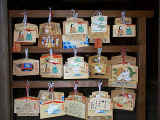 Documents from late in the war indicate that the
city was actually on the short list of targets being slated for one of the two
ultra-destructive A-bombs. It was the influential voice of Henry L. Stimson, then U.S.
Secretary of War, who proposed sparing the city that he called "a shrine of Japanese
art and culture". While figuratively it's only one 'shrine', but more literally, it
boasts more than 200 actual shrines. Oh, and over 1,600 temples, along with thousands of
historical houses and shops, all packed into these wonderfully curious little
neighborhoods. Documents from late in the war indicate that the
city was actually on the short list of targets being slated for one of the two
ultra-destructive A-bombs. It was the influential voice of Henry L. Stimson, then U.S.
Secretary of War, who proposed sparing the city that he called "a shrine of Japanese
art and culture". While figuratively it's only one 'shrine', but more literally, it
boasts more than 200 actual shrines. Oh, and over 1,600 temples, along with thousands of
historical houses and shops, all packed into these wonderfully curious little
neighborhoods.
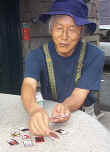 Fortunately, we still have the
majority of the afternoon to explore one of these historical downtown areas, the one
between Shimogyo-ku and Higashiyama-ku. With the help of our guide Hajime Hirooka (or, as
he likes to call himself, Johnny Hillwalker), we leisurely wander the centuries-old
streets, occasionally ducking through a twisting back alleyway or two, only to pop out
again on yet another narrow avenue, lined with neat rows of machiya (townhouses). From the
outside, each home looks calm and quiet, even empty. But behind the ricepaper shades,
there's often a flurry of activity. Fortunately, we still have the
majority of the afternoon to explore one of these historical downtown areas, the one
between Shimogyo-ku and Higashiyama-ku. With the help of our guide Hajime Hirooka (or, as
he likes to call himself, Johnny Hillwalker), we leisurely wander the centuries-old
streets, occasionally ducking through a twisting back alleyway or two, only to pop out
again on yet another narrow avenue, lined with neat rows of machiya (townhouses). From the
outside, each home looks calm and quiet, even empty. But behind the ricepaper shades,
there's often a flurry of activity.
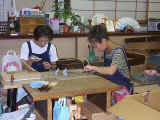 As following the traditional ways of the city's
tradesmen, family members toil in cottage workshops, crafting Kyoto specialties such as
prayer beads, ceramics, and those famous folding fans (invented, centuries ago, right here
in Kyoto). We pop into one such folding fan, or Kyo-sensu studio, to spy on two young
ladies working together to glue paper onto the fan's wooden spikes. Another stop treats us
to an impromptu demonstration of the delicate art of ceramic painting. We wind up our
walk, just as the heavens open with a pouring rain, with a dash into a rustic
confectionery and tea house for a button-sized sweet and a miniature cup of green tea. As following the traditional ways of the city's
tradesmen, family members toil in cottage workshops, crafting Kyoto specialties such as
prayer beads, ceramics, and those famous folding fans (invented, centuries ago, right here
in Kyoto). We pop into one such folding fan, or Kyo-sensu studio, to spy on two young
ladies working together to glue paper onto the fan's wooden spikes. Another stop treats us
to an impromptu demonstration of the delicate art of ceramic painting. We wind up our
walk, just as the heavens open with a pouring rain, with a dash into a rustic
confectionery and tea house for a button-sized sweet and a miniature cup of green tea.
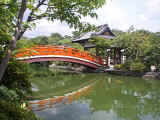 We've spent the earlier part of this, our second
day in Kyoto, taking in the simple splendor of even more of the ancient capital's temples
and castles. There was Nijo-jo Castle with it's 'nightingale floors' - floorboards
designed to squeak like birds, warning the ruling shogun of possible intruders. And then
To-ji Temple with its tempting Kobo-san Market. Now it's time for a little R&R. Now,
more towards the end of our trip, it's become fairly rare that we follow the advice of
guide books when selecting a place for chow. Generally, searching until we find someplace
that 'looks interesting' has proven to yield more culturally, if not sometimes more
gastronomically, rewarding experiences. We've spent the earlier part of this, our second
day in Kyoto, taking in the simple splendor of even more of the ancient capital's temples
and castles. There was Nijo-jo Castle with it's 'nightingale floors' - floorboards
designed to squeak like birds, warning the ruling shogun of possible intruders. And then
To-ji Temple with its tempting Kobo-san Market. Now it's time for a little R&R. Now,
more towards the end of our trip, it's become fairly rare that we follow the advice of
guide books when selecting a place for chow. Generally, searching until we find someplace
that 'looks interesting' has proven to yield more culturally, if not sometimes more
gastronomically, rewarding experiences.
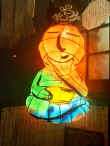 Anyway, so far this place - 'A-Bar' - has offered us both. Our book bragged
it to be "the best place to start the evening, in any season", so here we are,
downing some beer and a few sakes with six young Japanese with whom we've ended up sharing
a table. Everyone's starting to loosen up, as our waiter hops over with one more brew.
While he demonstrates his skill with chopsticks (by popping the top off of our next
bottle), Laura's complimenting Yoko, one of the girls next to her, on her ying/yang
earrings. Anyway, so far this place - 'A-Bar' - has offered us both. Our book bragged
it to be "the best place to start the evening, in any season", so here we are,
downing some beer and a few sakes with six young Japanese with whom we've ended up sharing
a table. Everyone's starting to loosen up, as our waiter hops over with one more brew.
While he demonstrates his skill with chopsticks (by popping the top off of our next
bottle), Laura's complimenting Yoko, one of the girls next to her, on her ying/yang
earrings.
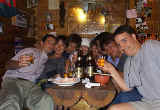 With what seems like less than even a second thought, Yoko takes her little
ear adornments off and gives them to Laura. "You like? Here, for you" she says
with a smile. Touched and surprised, Laura takes hers out of her lobes, and hands them to
Yoko. "They're not nearly as pretty as yours, but here, you can have mine".
Laura offers. They embrace, jewelry swappers, and now new found friends. Yep, this
is it I think to myself. This is just how I thought . . no, no, more like I hoped,
yeah hoped it would be, to visit this strange and unfamiliar land across the sea.
"Kampai" (cheers) I offer raising my glass to our new found friends.
"Here's to Japan!" "Kampai!" they all toast back, in hearty agreement. With what seems like less than even a second thought, Yoko takes her little
ear adornments off and gives them to Laura. "You like? Here, for you" she says
with a smile. Touched and surprised, Laura takes hers out of her lobes, and hands them to
Yoko. "They're not nearly as pretty as yours, but here, you can have mine".
Laura offers. They embrace, jewelry swappers, and now new found friends. Yep, this
is it I think to myself. This is just how I thought . . no, no, more like I hoped,
yeah hoped it would be, to visit this strange and unfamiliar land across the sea.
"Kampai" (cheers) I offer raising my glass to our new found friends.
"Here's to Japan!" "Kampai!" they all toast back, in hearty agreement.
|



